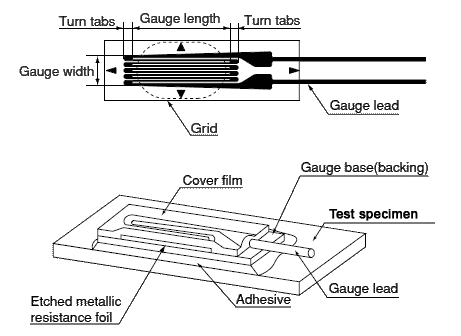Strain Measurement Solutions
We provide strain gauge measurement Services for over 40 years. With TML’s best technology and equipments on our side we always have an advantage over others. Our usual goal is to understand our valued clients requirement and suggest an optimized solution.
What is STRAIN
External force applied to an elastic material generates stress, which subsequently generates deformation of the material. At this time, the length L of the material extends to L+ΔL if applied force is a tensile force. The ratio of ΔL to L, that is ΔL/L, is called strain. (Precisely, this is called normal strain or longitudinal strain.) On the other hand, if compressive force is applied, the length L is reduced to L- ΔL. Strain at this time is (- ΔL)/L. Strain is usually represented as ε . Supposing the cross sectional area of the material to be A and the applied force to be P, stress σ will be P/A, since a stress is a force working on a definite cross sectional area. In a simple uniaxial stress field as illustrated below, strain ε is proportional to stress σ, thus an equation σ = E × ε is satisfied, provided that the stress σ does not exceed the elastic limit of the material. “E” in the equation is the elastic modulus (Young’s modulus) of the material.


ε = ΔL/L
ε : Strain
L : Original length
ΔL : Change due to force P
Because a strain is a ratio between length of two parts, it is a quantity having no dimension. Usually it is represented in a unit of 1×10-6, since the ratio of deformation is often very small. For example, supposing L to be 100mm and ΔL to be 0.1mm, strain ε is indicated as 1000×10-6strain, because “0.1mm/100mm=0.001=1×10-3=1000×10-6“. To indicate comparatively large strain, “% strain” is also used. In this case, 1% strain equals to 10000×10-6strain.
STRAIN GAUGE CONFIGURATION
A strain gauge is constructed by bonding a fine electric resistance wire or photographically etched metallic resistance foil to an electrical insulation base using an appropriate bonding materials,and attaching gauge leads.

SELECTING STRAIN GAUGES
Strain gauges are provided with many convenient features, but they also have limitations. Each strain gauge has its limitations in terms of temperature, fatigue, the amount of strain, and the measurement environment. These limitations must be examined before a strain gauge is used.
- Strain Gauge Features
- Simple construction with a small mass and volume so as not to interfere with the stresses on the specimen.
- Short distance between measuring points for localized evaluation.
- Good frequency response for tracking rapid fluctuations in stress.
- Simultaneous measurement of multiple points and remote measurement.
- Electrical output for easy data processing.
Detailed material
Contributions
Record Tech Electronics welcomes Case History contributions. If you have a project you would like to be considered for inclusion in our Case History section, please submit details along with 2 or 3 suitable images to the Record Tech Electronics Web Manager.
